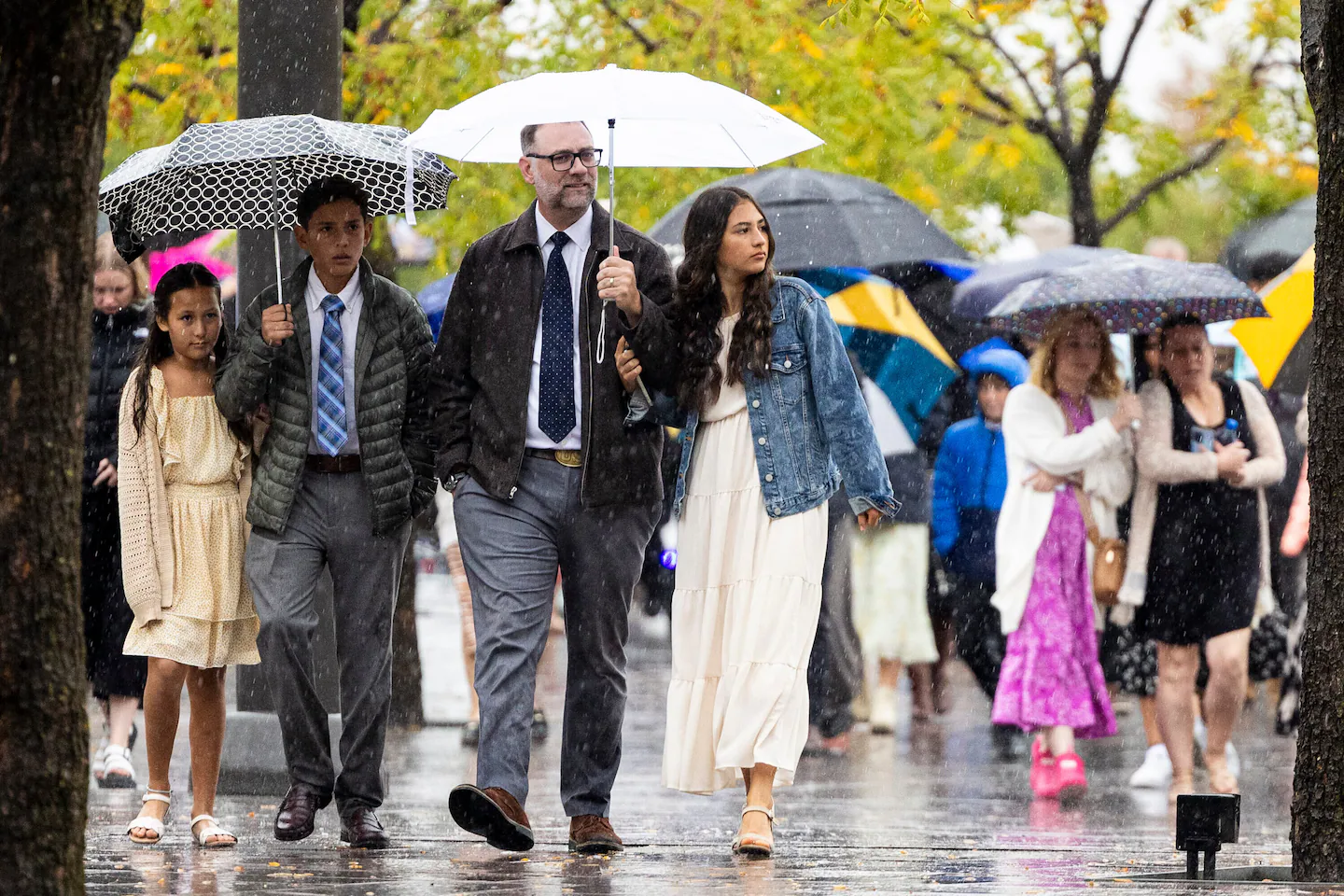
Just weeks earlier, conservative activist Charlie Kirk was assassinated on a college campus less than an hour from Salt Lake City, putting the church’s home region at the epicenter of the national story of cultural polarization and political violence.
Multiple speakers, who are drawn from the highest levels of leadership in the church, welled up with tears as they spoke onstage and in interviews over the weekend.
Elder Gary E. Stevenson was one of several speakers to refer directly to the attack in Grand Blanc, Michigan, from the stage. “Our hearts are mourning loss,” Stevenson, who belongs to the second-highest leadership body in the church, told attendees Saturday morning in a talk urging the necessity of peacemaking, even in an atmosphere of violence.
The church has endured the period of mourning without an official leader. At the conference, Dallin H. Oaks, the church’s presumed next president, signaled a familiar priority for the church’s future, telling members in the final address Sunday that they should resist national trends of declining marriage and birth rates.
“In the United States, we are suffering from a deterioration in marriage and childbearing,” Oaks said. He exhorted listeners to remember “the purpose of marriage and the value of children.”
Oaks, 93, will formally assume the presidency sometime after the funeral of Nelson, who died just a week before the scheduled conference opened at a cavernous church building in downtown Salt Lake City.
The church has not announced the official timing of the transition, but a gap between leaders has not lasted longer than two weeks since the 19th century. Nelson’s public viewing will take place on Monday in the same building as the conference, and the funeral will be held here on Tuesday.
Oaks will assume leadership of the church at a moment when fraught internal conversations around gender, sexuality, the family, and religious liberty have mirrored debates in the broader American culture and the courts. The Trump administration has backed policies aimed at persuading more Americans to marry and have more babies, and to have one parent stay at home with young children.
In an exchange at Utah Valley University before he was killed, Kirk praised the group he referred to as Mormons, admiring them for having large families.
But “you’ve got to get your mojo back,” he said. “No more of this LGBT stuff.”
Latter-day Saints leaders meet privately in smaller groups while in town for a meeting known as General Conference, but most of the proceedings from the stage focused on spiritual edification. Choirs, including the Tabernacle Choir at Temple Square — formerly the Mormon Tabernacle Choir — sang hymns between sermons.
Founded in New York in the 19th century, the church is headquartered in Salt Lake City because violent opposition drove early church members farther and farther west. Some who traveled to the conference said that history was on their minds.
“There’s a lot of persecution toward the church, since the beginning,” said Shelise Mayer, 40, who traveled from Eagar, Arizona, with her family of seven. “This is something that comes with being a member of the Church of Jesus Christ of Latter-day Saints.”
Only 15 percent of Americans have a favorable view of Latter-day Saints, according to a 2022 survey conducted by the Pew Research Center. That is lower than the numbers for every other group in the survey, including Muslims and atheists.
Latter-day Saints represent about 2 percent of the population in the US. Almost half of Americans raised in the church leave it in adulthood, according to the Pew Research Center. But the church is also attracting new followers in the US and overseas, according to internal numbers presented publicly for the first time at the conference. Almost one million people have joined the church in the last three years, representing approximately 5 percent of the total membership. Conversions increased this year compared to the previous year in regions including North America, Europe, Asia, and Africa.
In his decades rising within the church hierarchy, Oaks has been a key shaper of the Latter-day Saints’ policy. In 1984, 20 years before Massachusetts became the first state to legalize same-sex marriage, Oaks drafted an influential memo encouraging the church to “vigorously” oppose its legalization. In 2019, as one of two official counselors to Nelson, he instructed church leaders that God’s creation of humans as male and female referred to “biological sex at birth,” a clarification of a doctrinal document that transgender Latter-day Saints and their allies had interpreted more expansively.
“Most of us in the LGBTQ space are frightened,” said Cynthia Winward, who lives in Provo, Utah, and hosts a feminist podcast focused on church issues. She recalled an address in which Oaks described God’s anger and wrath as evidence of his love, and an interview in which he suggested parents of gay adult children might not welcome them into the family home.
Winward, who has a gay daughter, did not attend the conference but tuned in to Oaks’s address Sunday.
Oaks will become the church’s 18th leader in 195 years, stepping into a role that church members view not just as an executive but also as a living prophet.
Because succession is determined by seniority within an existing leadership body, Oaks’s ascent to the role is essentially guaranteed.